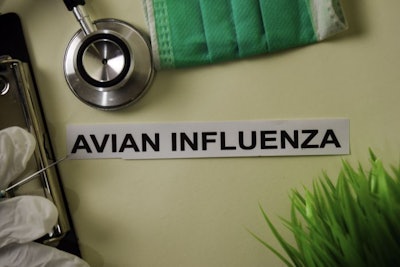
Continuing the recent pattern of outbreaks, highly pathogenic avian influenza (HPAI) has been confirmed for the first time in new areas of Bulgaria and Vietnam. Further cases have also been recorded in the Czech Republic and Taiwan.
Avian influenza in Bulgaria
Bulgaria has reported its first cases of highly pathogenic avian influenza (HPAI) of the H5N8 virus variant since April of 2019.
According to the agriculture ministry’s latest report to the World Organisation for Animal Health (OIE), the outbreak occurred in the region of Plovdiv in central Bulgaria. Starting on February 17, more than 9,100 birds died at the farm, and a further 5,830 head of poultry have been culled. The source of the infection is unknown, although the same virus has been detected lately in other central European countries.
The affected flock was in the town of Rakovski, reported Novinite, and the birds were mulards, a commercial duck hybrid. Authorities were inspecting the 25 other poultry farms within 3 kilometers of the outbreak, and a further 24 premises in the 10-kilometer surveillance zone.
This was the first HPAI outbreak in Bulgaria since April of 2019, according to the OIE report.
In October of 2018, more than 100,000 chickens and 16,000 ducks were culled by Bulgarian authorities to control the spread of HPAI, reported Radio Free Europe.
Confirmation of the disease in Bulgaria brings the total number of European countries reporting HPAI so far this year to eight, according to Italian health authority and research organization for animal health and food safety (IZSVe). Poland recorded the first outbreak of the winter on the last day of 2019.
Over the past week, animal health agencies in Hungary and Ukraine have reported to the OIE that no new cases have been confirmed in their respective countries.
Second outbreak in Czech Republic
The Czech Republic’s Veterinary Administration has confirmed to the OIE a second outbreak of HPAI. The H5N8 virus subtype was detected at a large poultry farm in Slepotice in the central region of Pardubice in mid-February. Around 1,300 of the 7,500 turkeys on the farm died. The surviving turkeys and 130,000 broilers were scheduled for culling and subsequent rendering.
This latest outbreak followed cases in a backyard flock in the neighboring region of Vysocina in January.
Dutch farmers to house commercial poultry
Concerned over a recent outbreak of HPAI in poultry in western Germany, commercial poultry farmers in the Netherlands have been advised to keep their birds housed. According to the Dutch central government, this action will reduce the risk of the transmission of the virus from wild birds.
There is also a regulation in place in the Netherlands for a second cleaning and disinfection procedure for vehicles transporting susceptible species from a country with avian flu. This measure is in place for trade with Germany. This procedure is overseen by the Dutch Food and Consumer Product Safety Authority (NVWA).
HPAI H5N1 returns to southern Vietnam
After a short absence, there have been two outbreaks of HPAI caused by the H5N1 virus variant in the south of Vietnam. These occurred among village flocks in the same district of Tra Vinh province, which is in the Mekong Delta region.
According to the agriculture ministry’s report to the OIE, just over 1,700 birds were involved in these outbreaks, with more than 400 mortalities. This virus was last detected in the region in June of last year, and the source of the current infection is unknown.
Meanwhile, the number of outbreaks linked to the H5N6 virus variant in northern Vietnam has risen to 16 since mid-January. A further six village flocks in the provinces of Thanh Hoa and Nghe An were confirmed with the disease in mid-February, according to the official report. More than 8,000 poultry were lost through mortality or culling as a result of these latest outbreaks.
Confirmation of the H5N1 outbreak has led the government in neighboring Cambodia to tighten restrictions on imports of poultry from Vietnam. The agriculture minister has announced a nine-point plan to keep the virus out of Cambodia, reports Phnom Penh Post. Measures include halting illegal imports, monitoring poultry health nationwide, raising awareness of the disease among poultry keepers, and improving biosecurity at farms.
Five new HPAI outbreaks in Taiwan
Over the past week, there have been five new outbreaks of HPAI linked to the H5N2 virus in Taiwan. All of these were on farms, according to the Council of Agriculture’s report to the OIE. More than 40,300 poultry were lost through mortality or destruction.
Four of the affected flocks were of native chickens, and the other outbreak was in meat ducks. Three of the farms were in Changhua county, and the other two in Yunlin.
As with previous outbreaks, Taiwan’s authorities have placed all infected farms under movement restrictions. All birds have been culled, and the premises have been thoroughly cleaned and disinfected. Poultry farms within three kilometers of each outbreak will be inspected and subjected to intensive surveillance for the following three months.
Based on reports to the OIE, there have been 20 confirmed outbreaks linked to the H5N2 virus in Taiwan since the start of 2020, leading to the direct loss of more than 204,300 poultry. The virus has been afflicting the country’s poultry sector since January of 2015.
This week, China has lifted a ban on the import of live poultry from the U.S. Put in place in 2015, the ban was imposed to prevent the spread of HPAI. In November of 2019, China lifted the ban to allow the import of import of U.S. poultry products.
Chinese authorities have recently confirmed HPAI outbreaks in poultry in the provinces of Sichuan and Hunan.
View our continuing coverage of the global avian influenza situation.

















